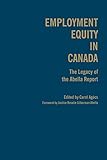Employment Equity in Canada : The Legacy of the Abella Report / Carol Agocs.
Material type: TextPublisher: Toronto : University of Toronto Press, [2014]Copyright date: ©2014Description: 1 online resource (352 p.) : 8 b&w tablesContent type:
TextPublisher: Toronto : University of Toronto Press, [2014]Copyright date: ©2014Description: 1 online resource (352 p.) : 8 b&w tablesContent type: - 9781442647565
- 9781442668515
- 331.13/30971 23
- online - DeGruyter
| Item type | Current library | Call number | URL | Status | Notes | Barcode | |
|---|---|---|---|---|---|---|---|
 eBook
eBook
|
Biblioteca "Angelicum" Pont. Univ. S.Tommaso d'Aquino Nuvola online | online - DeGruyter (Browse shelf(Opens below)) | Online access | Not for loan (Accesso limitato) | Accesso per gli utenti autorizzati / Access for authorized users | (dgr)9781442668515 |
Frontmatter -- Contents -- Foreword -- Acknowledgments -- Introduction. Perspectives on Employment Equity in Canada -- Chapter 1. The Making of the Abella Report: Reflections on the Thirtieth Anniversary of the Report of the Royal Commission on Equality in Employment -- Chapter 2. Employment Equity in Canada: What Do the Data Show about Its Effectiveness? -- Chapter 3. Real Change? Reflections on Employment Equity’s Last Thirty Years -- Chapter 4. Women, Intersectionality, and Employment Equity -- Chapter 5. Employment Equity and Canada’s Aboriginal Peoples -- Chapter 6. Employment Equity and Disability: Moving Forward to Achieve Employment Integration and Fulfil Promises of Inclusion and Participation -- Chapter 7. The Equity Landscape for Sexual Minorities in Canada -- Chapter 8. Remedying the Experiences of Vulnerable Workers: Links with Employment Equity -- Chapter 9. Employment Equity in the Federal Public Service: A Union Perspective -- Chapter 10. Securing Employment Equity by Enforcing Human Rights Laws -- Chapter 11. The Employment Equity Mandate of the United Nations Convention on the Rights of Persons with Disabilities: Some Preliminary Observations for Canada -- Chapter 12. New Narratives, Same Old Problems: The Risk of Diversity-Centred Workplace Decision-Making in a “Post-Racial” America -- Chapter 13. Employment Equity: The Next Thirty Years -- Conclusion. Looking Forward: The Unfinished Business of Employment Equity -- Contributors -- Index
restricted access online access with authorization star
http://purl.org/coar/access_right/c_16ec
In the mid-1980s, the Abella Commission on Equality in Employment and the federal Employment Equity Act made Canada a policy leader in addressing systemic discrimination in the workplace. More than twenty-five years later, Employment Equity in Canada assembles a distinguished group of experts to examine the state of employment equity in Canada today.Examining the evidence of nearly thirty years, the contributors – both scholars and practitioners of employment policy – evaluate the history and influence of the Abella Report, the impact of Canada’s employment equity legislation on equality in the workplace, and the future of substantive equality in an environment where the Canadian government is increasingly hostile to intervention in the workplace. They compare Canada’s legal and policy choices to those of the United States and to the UN Convention on the Rights of Persons with Disabilities, and examine ways in which the concept of employment equity might be expanded to embrace other vulnerable communities. Their observations will be essential reading for those seeking to understand the past, present, and future of Canadian employment and equity policy.
Mode of access: Internet via World Wide Web.
In English.
Description based on online resource; title from PDF title page (publisher's Web site, viewed 01. Dez 2023)


